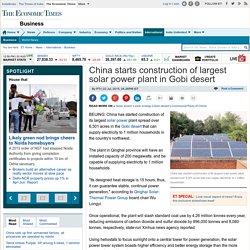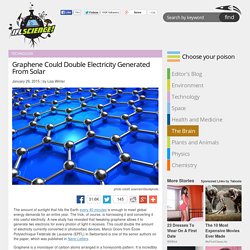

China starts construction of largest solar power plant in Gobi desert - The Economic Times. BEIJING: China has started construction of its largest solar power plant spread over 6,301 acres in the Gobi desert that can supply electricity to 1 million households in the country's northwest.

The plant in Qinghai province will have an installed capacity of 200 megawatts, and be capable of supplying electricity to 1 million households. "Its designed heat storage is 15 hours, thus, it can guarantee stable, continual power generation," according to Qinghai Solar-Thermal Power Group board chair Wu Longyi. Once operational, the plant will slash standard coal use by 4.26 million tonnes every year, reducing emissions of carbon dioxide and sulfur dioxide by 896,000 tonnes and 8,080 tonnes, respectively, state-run Xinhua news agency reported. Using heliostats to focus sunlight onto a central tower for power generation, the solar power tower system boasts higher efficiency and better energy storage than the more commonly used trough system.
Klou. A new model of the Sun's solar cycle is producing unprecedentedly accurate predictions of irregularities within the Sun's 11-year heartbeat.

The model draws on dynamo effects in two layers of the Sun, one close to the surface and one deep within its convection zone. Predictions from the model suggest that solar activity will fall by 60 per cent during the 2030s to conditions last seen during the 'mini ice age' that began in 1645. Results will be presented today by Prof Valentina Zharkova at the National Astronomy Meeting in Llandudno. It is 172 years since a scientist first spotted that the Sun's activity varies over a cycle lasting around 10 to 12 years. But every cycle is a little different and none of the models of causes to date have fully explained fluctuations. Wendy L Schultz sur Twitter : "'Mini ice age' forecast for 2030-40 by #solar output model new #Maunder Minimum? A 'mini ice age' is coming in the next 15 years. A new model that predicts the solar cycles more accurately than ever before has suggested that solar activity will drop by 60 percent between 2030 and 2040, which means in just 15 years’ time, Earth could sink into what researchers are calling a mini ice age.

Such low solar activity has not been seen since the last mini ice age, called the Maunder Minimum, which plunged the northern hemisphere in particular into a series of bitterly cold winters between 1645 and 1715. The prediction is based on what’s known as the Sun’s '11-year heartbeat'. The Sun’s activity is not the same year in year out, it fluctuates over a cycle that lasts between 10 and 12 years. Ever since this was discovered 172 years ago, scientists have struggled to predict what each cycle will look like. Lanzavecchia + Wai's cooking set uses the sun to barbecue.
Design duo Lanzavecchia + Wai has incorporated a lens into an outdoor furniture set to concentrate sunlight onto a grilling plate for cooking food.

Italian designer Francesca Lanzavecchia and Hunn Wai from Singapore intend the SUNPlace set to function as a cross between a barbecue and teppanyaki – a type of flat grill used in Japanese cuisine. On a sunny day, a glass lens mounted above a table concentrates the natural light onto a cast-iron grill embedded in the surface. "We were inspired by the convivial cooking experiences of fondues, Chinese hot pots and Korean barbecues," Wai told Dezeen. France Declares All New Rooftops Must Be Topped With Plants Or Solar Panels. A new law recently passed in France mandates that all new buildings that are built in commercial zones in France must be partially covered in either plants or solar panels.

Green roofs, as they are called, have an isolating effect which helps to reduce the amount of energy needed to heat a building during the winter or cool it in the summer. They are capable of retaining rainwater and reducing problems with runoff, and also offer birds a place to call home in the urban jungle. A Test Of Nevada's Solar Tower Project Torched Over A Hundred Birds Twitter. Graphene Could Double Electricity Generated From Solar. The amount of sunlight that hits the Earth every 40 minutes is enough to meet global energy demands for an entire year.

The trick, of course, is harnessing it and converting it into useful electricity. A new study has revealed that tweaking graphene allows it to generate two electrons for every photon of light it receives. This could double the amount of electricity currently converted in photovoltaic devices. Marco Grioni from École Polytechnique Fédérale de Lausanne (EPFL) in Switzerland is one of the senior authors on the paper, which was published in Nano Letters. World's first solar battery claimed to "run on light and air" Researchers at Ohio State University (OSU) have created a dye-sensitized solar cell that stores its own power by "breathing" air to decompose and re-form lithium peroxide.

Its creators believe the device, which effectively combines a battery and a solar cell in one, could reduce renewable energy costs by 25 percent. "The state of the art is to use a solar panel to capture the light, and then use a cheap battery to store the energy," explains OSU professor Yiying Wu. "We've integrated both functions into one device. IBM’s solar concentrator can produce energy, clean water and AC. IBM Research and Switzerland-based Airlight Energy today announced a new parabolic dish that increases the sun's radiation by 2,000 times while also producing fresh water and air conditioning.

The new Concentrator PhotoVoltaics (CPV) system uses a dense array of water-cooled solar chips that can convert 80% of the sun's radiation into useful energy. IBM, Airlight The CPV, which looks like a 33-foot-high sunflower, can generate 12 kilowatts of electrical power and 20 kilowatts of heat on a sunny day — enough to power several average homes, according to Bruno Michel, the project's lead scientists at IBM Research in Switzerland.
The mirrors concentrate the sun on the chips to produce electricity. Normally, the chips would ignite, since they reach temperatures of 1,500 degrees Celsius. The dense array of multi-junction photovoltaic (PV) chips, mirrors and the electrical receiver are encased in a large inflated transparent plastic enclosure to protect the system from rain or hail. (2) Twitter. Transparent solar collectors may replace conventional windows. Researchers working at Michigan State University (MSU) have created a completely transparent solar collector which is so clear that it could replace conventional glass in windows.

The new devices – dubbed transparent luminescent solar concentrators – have the potential to not only turn windows into solar electric generators, but the screens of smartphones, vehicle glazing, and almost anything else that has a see-through surface. Experiments with transparent solar collectors have been conducted for quite some time now, but they have resulted in variable success and many poor results – particularly around the inefficient production of energy. More to the point, most of the produced materials weren't completely transparent, rather being brightly-colored or too darkly tinted. "No one wants to sit behind colored glass," said Richard Lunt, assistant professor of chemical engineering and materials science at MSU. Movie: Julian Melchiorri on the first synthetic biological leaf. The "first man-made biological leaf" could enable humans to colonise space Dezeen and MINI Frontiers: RCA graduate Julian Melchiorri says the synthetic biological leaf he developed, which absorbs water and carbon dioxide to produce oxygen just like a plant, could enable long-distance space travel.

"Plants don't grow in zero gravity," explains Melchiorri. "NASA is researching different ways to produce oxygen for long-distance space journeys to let us live in space. This material could allow us t0 explore space much further than we can now. " Melchiorri's Silk Leaf project, which he developed as part of the Royal College of Art's Innovation Design Engineering course in collaboration with Tufts University silk lab, consists of chloroplasts suspended in a matrix made out of silk protein. Germany's green energy boom is leaving a 'trail of blood' on coal companies. Germany sets record for single day energy use – 50 percent comes from solar. The Fraunhofer ISE research institute has announced that Germany set a record high for solar use on June 9—on that day 50.6 of all electricity consumed in the country came from solar power.
The record occurred over a holiday, which meant less demand, but it still marks a major step forward for the world's solar power leader. Despite not having a generally sunny climate, Germany has been pushing solar energy—but not from the huge solar farms seen in other countries. In Germany, the focus has been on rooftop solar collectors mounted on homes, businesses and buildings of any other kind. Currently, over 90 percent of mounted solar panels in the country are on rooftops. The country broke two other records around the same time, producing 24.24 GW of solar generated power between 1 and 2pm on June 6, and over that entire week, the country produced 1.26 TWh of electricity from solar power.
CSIRO sets world record in generating "supercritical" steam using solar power. In what it is claiming as a world record and breakthrough for solar thermal energy, researchers at Australia's CSIRO have used solar energy to generate "supercritical" steam at its solar thermal test plant in Newcastle, Australia. Using a field of more than 600 directional mirrors (heliostats) directed at two towers housing solar receivers and turbines, the researchers generated steam at a pressure of 23.5 mpa (3,400 psi) and 570° C (1,058° F). View all. Solar FREAKIN Roadways, are they real? What you need to know about solar energy. Solar Power and Future Growth. The opportunity is immense Solar is still a relatively immature industry. About 0.2% of electricity in the U.S. comes from solar generation and solar has been installed on less than 250,000 homes in the U.S.
If a building or structure receives direct sunlight and uses electricity solar could be used to generate some of that electricity. The residential market potential is immense: there are more than 90 million single family homes in the U.S. and as many as 50 million more households in multi-family structures and several million more commercial and other non-residential structures. Solar energy prospects are bright for Scotland, experts say. Installing state-of-the-art solar panels on a quarter of a million roofs could meet one-sixth of Scotland's electricity demands, experts say. Scientists say the strategy could ease the plight of one in three Scottish households, which currently struggle to provide themselves with adequate heat and hot water.
Researchers, business leaders and public sector experts have contributed to a report which sets out how Scotland could benefit from solar power. They say harnessing energy from the sun on the roofs of south-facing buildings could have significant economic, environmental and social impacts. The project - involving researchers at the University of Edinburgh - provides the most comprehensive assessment yet of Scotland's solar energy potential. Findings from the project reveal that solar power could help Scotland meet renewable energy targets, create jobs and ensure the energy needs of people in cities and rural areas are met.
Denmark leads the charge in renewable energy. Denmark has lofty goals: By 2020, the country aims to produce 70 percent of its energy from renewable sources and to make the switch to renewables completely by mid-century. "Today, we're already at 43 percent," said Kristoffer Böttzauw, the deputy director general of the Danish energy agency Energistyrelsen, which coordinates Denmark's energy policy. "At present, renewable energy sources account for about 25 percent of Denmark's total energy consumption," said Böttzauw. He's convinced that the country's goal to completely abandon coal, oil and gas by 2050 is realistic. 'EU trailblazer' Tobias Austrup, an expert on renewables for Greenpeace, is looking for that same ambition from the German government and industry.
Austrup sees the Danish energy policy as a blueprint for Europe and Germany. Solar thermal magazine. Larry Ellison's Island Models Green Energy. Solar-panel skin could make Dutch homes energy neutral. The World's Largest Solar Plant Started Creating Electricity Today. Rawlemon's New Betaray Crystal Ball Harvests Light From The Sun, Moon and Clouds! In 2012, Inhabitat featured an invention that promised to turn the world of solar power generation upside down. Rawlemon‘s spherical solar energy-generating globe looked a lot like a giant glass marble on a robotic steel frame, but there was nothing raw about what it achieved: the sun-tracking device was capable of concentrating sunlight (and moonlight) up to 10,000 times–making it 35 percent more efficient than traditional dual-axis photovoltaic designs. Bolstered by the incredible enthusiasm for their first design, the scientists at Rawlemon are back with an updated version–behold the Betaray!
Good vibrations lead to efficient excitations in hybrid solar cells. Hippies and libertarians have become unlikely allies in a war against solar power - Quartz. A weird thing is happening with solar power. For years derided as a sideshow energy source that was only for environmentalists, solar is now being seen as an imminent threat to both the mainline energy industry and at least one national economy. As a result, those harmless people with the shiny panels on their rooftops are suddenly being seen as dangerous freeloaders and, in some potential bellwether cases, are being threatened with punitive taxes to dissuade them from their pursuit of self-generated power from a renewable resource: the Sun. But the strongest responses to tightening the screws on solar aren’t only coming from the traditional green community: a populist pro-solar resistance may be taking root, seeing independent power generation as a right.
As a result, the shape of the future pro-solar, even pro-innovation coalitions, could be anyone’s guess. ¡Viva el Sol! Bottomless subsidies The government’s response has been about as damaging as its initial policies turned out to be. BIPV May Take Off. Artificial Leaf Holds Potential for Developing Countries. Rawlemon's Spherical Solar Energy-Generating Globes Can Even Harvest Energy from Moonlight.
Making solar cells with a kitchen microwave. Just stick this portable outlet to your window to start using solar power. Renewable Energy in 50 Years: 3 Predictions. Lancaster, California to Require All New Homes to Have Solar Panels. Urbee. In Australia, Wind Power is Already Cheaper Than Fossil Fuels and Solar is Right Behind. The Future of Solar? - Products. SMIT_grow. Nano-sandwich material claimed to boost solar cell efficiency by 175 percent.
Princeton, Navy and Air Force Team on Biomimicry Solar Cell Research. Solar Installers Offer Homeowners Deals, Gaining Converts. Solar Potential Uncorked At Winery Of The Future. Here Comes the Sun! Dow Solar rolls out Solar Shingles in California and Texas. Solar Installers Offer Homeowners Deals, Gaining Converts. Hawaii is overflowing with solar power because it’s obnoxiously perfect. Desertec Moves Forward.